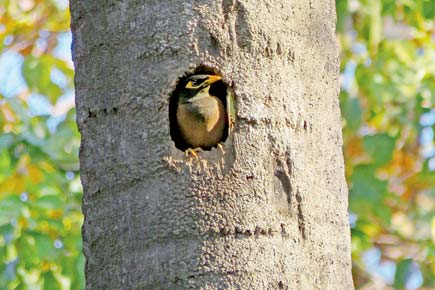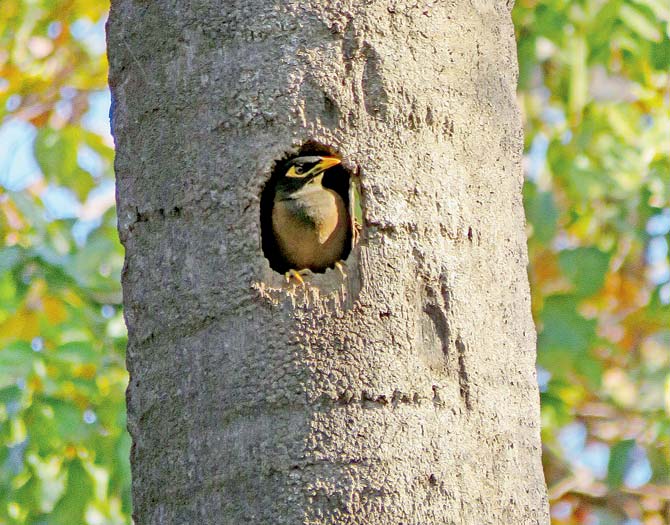A fortnight ago, I had the good fortune of attending the Student Conference on Conservation Science (SCCS) at the IISc-Bengaluru Campus


A common myna explores a nesting hole in a dead toddy palm
ADVERTISEMENT
 A fortnight ago, I had the good fortune of attending the Student Conference on Conservation Science (SCCS) at the IISc-Bengaluru Campus. As a part of the conference activities, there were several walks conducted in the lush IISc Campus, viz. Tree Walks, Bird Walks and Loris Walks. I had the good fortune of enjoying the latter two. While on the bird walk, the group sighted many insectivorous birds, such as Tickell’s Blue Flycatcher, Great Tit, and Greenish Warbler, among others. And, excitedly, I enquired about the population of Grey or any other Hornbills sighted in the campus. The answer was an astounding zero.
A fortnight ago, I had the good fortune of attending the Student Conference on Conservation Science (SCCS) at the IISc-Bengaluru Campus. As a part of the conference activities, there were several walks conducted in the lush IISc Campus, viz. Tree Walks, Bird Walks and Loris Walks. I had the good fortune of enjoying the latter two. While on the bird walk, the group sighted many insectivorous birds, such as Tickell’s Blue Flycatcher, Great Tit, and Greenish Warbler, among others. And, excitedly, I enquired about the population of Grey or any other Hornbills sighted in the campus. The answer was an astounding zero.
The fact that Grey Hornbills had become extinct on such a lush campus was shocking for me. On analysing, I realised that the reasons may be manifold. Firstly, the huge variety of exotic trees planted in our cities provides little or no food for frugivorous birds. Secondly, the habit of estate managers and landscape architects of cutting down and removing dead and decaying branches and trees, destroys crucial locations for hole-nesting birds and mammals. In most landscapes, wild or urban, woodpeckers are a keystone species as they are the primary hole-makers. In case of Mumbai, to this list we can add the coppersmith and other barbets, which are also minor hole-creators.
Old trees replaced
Sadly, we too have documented the loss of Grey Hornbills from many of our urban campuses, such as the Bhavan’s College Munshinagar campus in Andheri. In many of our old campuses, we have seen the replacing of tall and broad trees such as Tamarind, Banyan, Terminalias, Jamun, Raintrees and Mango with short, narrow and unbranched species such as False Ashoka, Bottle and coconut palms or Drasina. This has lead to loss of potential breeding sites for larger birds such as grey hornbills, barn and other owls. Populations of house sparrows, magpie robins, spotted owlets, common mynas, brahminy starlings, rose-ringed and alexandrine parakeets have also been affected by this loss of nesting holes. They have to sadly compete with the more aggressive Palm Squirrels and in some cases even bandicoot and brown rats that climb up trees and buildings to raid, destroy and take over their nesting sites.
Nesting styles changed
The plantation of soft-wooded Gulmohar and copperpod trees and the spread of Peepul trees along major roads have seen Coppersmith barbets thrive all over Mumbai. They are commonly seen drilling into dead branches and feasting on the banyan and peepul fruits. But, their nests are very narrow and usually either slanting or even open directly downwards, making them useless for most other hole-nesters. Sparrows and common mynas have adapted their nesting style to tuck grass and pieces of cloth behind air-conditioners or in streetlight frames. Similarly, barn owls have adapted to nesting in broken sewage pipes, behind signage boards and hoardings of new-age buildings.
The biggest blow has been delivered to true hole-nesters such as civets, parakeets and magpie robins, among others. And, our woodpeckers have almost disappeared from the scene, only to be seen in very few balanced forested patches of the Aarey Milk Colony, Mulund Hill and IIT Campus. Thankfully, many organisations, viz. SPROUTS, Aranya, BNHS and Sparrow Shelter provide well-designed nest boxes, which can be easily installed in urban towers. It is heartening to see some conscientious people put up specially designed wooden nest boxes, earthen pots, bamboos, PVC pipes and jerry cans as nesting set-ups to accommodate these homeless urban hole-nesters.
Write to Anand at sproutsenvttrust@gmail.com
 Subscribe today by clicking the link and stay updated with the latest news!" Click here!
Subscribe today by clicking the link and stay updated with the latest news!" Click here!






